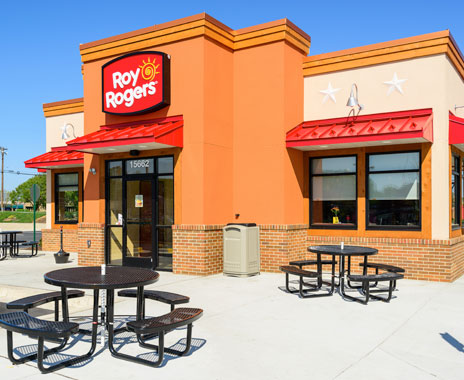Most Millennials wouldn’t know Roy Rogers, the iconic Western movie star, from a cowboy’s tin of beans.
That’s utterly irrelevant to Roy Rogers, the Frederick Maryland–based quick-service chain that’s making a steady turnaround in a serious bid for 21st century relevance. Never mind that even McDonald’s is struggling for fast-food footing in an industry evolution that’s placed the likes of Chipotle, Panera Bread, and Five Guys as the new wave of culinary relevance.
Roy Rogers—the iconic restaurant where folks can mosey in for high-quality burgers, fried chicken, and roast beef sandwiches—is back in the saddle with a new, Millennial-friendly gait.
The updated stores have WiFi. Some Roy Rogers stores have flat-screen TVs. And new units even have communal tables, which have become so popular with younger customers.
“They’re typically the first tables taken,” says Jim Plamondon, co-president of Roy Rogers Franchise Company. Plamondon owns the 48-unit chain along with his brother, Pete Plamondon Jr. While familiar imagery of the actor Roy Rogers is still visible in the new locations, the contemporary look is far more about exposed beam ceilings, bold color schemes, and fancy-looking floors that—while tile—could easily pass for hardwood.
Roy Rogers, the chain, is alive, well, and expanding with up to four new franchise restaurants and one to two new company-owned stores planned for each year over the next five years. Sure, the chain is still a long way from its peak of 648 restaurants, which it achieved when Marriott Corp. owned it from 1968 until 1990. But after the chain’s tailspin under Hardee’s ownership in the 1990s, there’s increasing determination from the new management team to reach out to a new cult of fans who will follow it on Facebook and Instagram and who may even hook into the chain’s first-ever loyalty program, planned to launch soon.
The chain’s challenge? Staying relevant.
“When we go into new markets, some folks say, ‘Gosh, I didn’t know you were still around,’” says Jim Plamondon, who along with his brother bought the chain from Hardee’s in 2002.
But to older consumers, the name screams quality, which is probably why its average unit sales volume—at almost $1.6 million for company-owned stores and $1.7 million for franchisees—ranks among the industry leaders. System-wide sales will exceed $80 million this year.
“We have almost a cult-like following,” Plamondon says. “When we open a new restaurant, we literally have lines out the door.”
He credits that to the chain’s fixation with quality. The burgers are all made to order. The roast beef, which is never frozen, is 100 percent USDA top choice round beef that’s cooked on-site. The fried chicken, which it recently increased 20 percent in size, is hand-battered.
Some even refer to Roy Rogers—with its cut-above food—as a predecessor to today’s fast-casual craze. Plamondon says he’s heard more than one customer say, “I don’t eat fast food, but I do eat at Roy Rogers.”
Then there’s that iconic brand name, which, while familiar and a sign of trustworthy quality, also represents a bygone era. Some Millennials presume that Roy Rogers their “grandparents’ fast-food chain,” says Robin DiPietro, a hospitality professor at the University of South Carolina.
What’s more, the iconic cowboy star behind the name has been dead for decades. “Ask any Millennial who Roy Rogers is and they’ll have no clue,” says Stuart Hunt, a franchisee who owns three locations in Alexandria, Virginia.
But Hunt relishes the challenge of selling Millennials on a brand that he bought into because of its unique tradition and unusually high quality. With Millennials fixated on customized foods, he says, many gravitate to the Fixin’s Bars at Roy Rogers, where they can add their own lettuce, tomatoes, onions, and salsa. “They can put whatever they want on their burgers,” he says.
Plamondon insists the Roy Rogers name is a positive—even now. “Roy conjures up the idea of cowboy values; good, honest, down-home cooking; and quality food with integrity,” he says.
Plamondon has special memories of not only meeting Rogers, but also chauffeuring him around to make special appearances at some of his own father’s Roy Rogers franchise restaurants. Plamondon was just 16 at the time—the ink was still fresh on his driver’s license—but he proudly drove Rogers around from store to store in his father’s station wagon.
“What I remember most is what a nice guy he was,” he says. “You wouldn’t know he was a big-time movie star.”
That’s the very image the chain is embracing—again—in a new era where social media buzz means everything.
Influential “street teams” of 20-something fans are even paid to show up at Millennial-friendly gatherings like local high school events and street festivals to spread the good word about Roy Rogers.
“We take a very proactive approach to connecting with younger people,” Hunt says. “It isn’t easy getting their attention. But we get in front of them and make them aware of who we are.”




